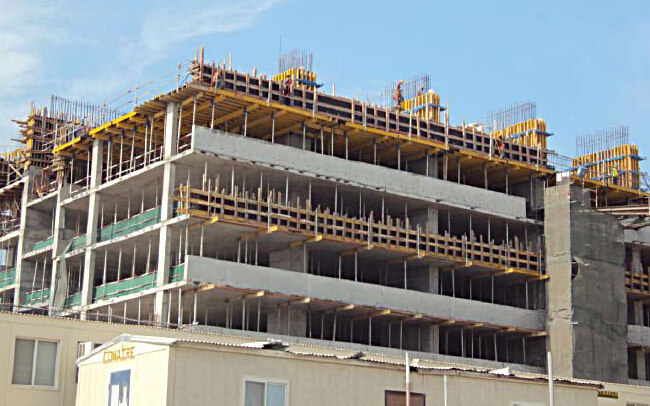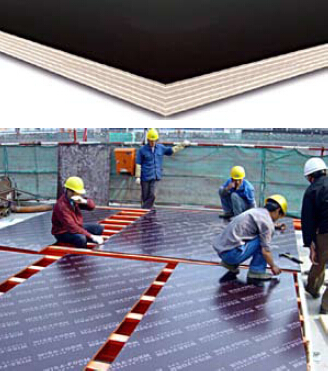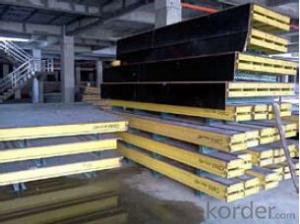Plywood Formwork system for Formwork and Scaffolding
- Loading Port:
- Tianjin
- Payment Terms:
- TT OR LC
- Min Order Qty:
- 50 g/m²
- Supply Capability:
- 1000 g/m²/month
OKorder Service Pledge
Quality Product, Order Online Tracking, Timely Delivery
OKorder Financial Service
Credit Rating, Credit Services, Credit Purchasing
You Might Also Like
Plywood --- make perfect concrete surface
WISA-Form Birch is a coated special plywood using in the formwork systems where high
requirements are set on the concrete surface and the times of reuses.
With CNBM timber beam & WISA plywood, the formwork is low weight but high load capacity, it is
widely used in construction.
Characteristics:
◆ Component with high standardization.
◆ Assembling in site, flexible application.
◆ Light weight, easy transportation and storage.


- Q:How does steel formwork affect the overall durability of a construction project?
- The overall durability of a construction project can be significantly impacted by steel formwork. One of the main advantages of using steel formwork is its strength and durability. Steel possesses high tensile strength, allowing it to withstand heavy loads and resist deformation. This strength is essential in maintaining the formwork's shape and integrity during construction. Furthermore, steel formwork is highly resistant to wear and tear, making it suitable for multiple uses and reuses. Unlike wood and other materials, steel does not easily degrade or deteriorate, ensuring the formwork remains in good condition for extended periods. This durability is particularly crucial in large-scale construction projects that require repetitive formwork installations. Additionally, steel formwork offers excellent dimensional stability. It does not warp or shrink under varying weather conditions, ensuring the accuracy and precision of the concrete structure being formed. This is essential to meet the required specifications and standards for the final construction project. The durability of steel formwork also contributes to the overall safety of the construction project. Its strength and stability prevent potential formwork failures that could lead to accidents or structural damages during the concrete pouring process. By providing a secure and reliable support system, steel formwork enhances worker safety and the long-term structural integrity of the building. Moreover, the durability of steel formwork translates into cost-effectiveness over the project's lifespan. The ability to reuse steel formwork reduces the need for constant replacement, saving time and money on material expenses. Additionally, the reduced maintenance required for steel formwork lowers ongoing maintenance costs, making it a cost-effective choice for construction projects. In conclusion, steel formwork significantly contributes to the overall durability of a construction project. Its strength, resistance to wear and tear, dimensional stability, and safety features ensure the formwork remains intact throughout the construction process. This durability not only enhances the structural integrity of the building but also provides cost-effectiveness and peace of mind for project stakeholders.
- Q:What are the different locking mechanisms used in steel formwork?
- There are several different locking mechanisms used in steel formwork to ensure stability and integrity during concrete construction projects. These mechanisms are designed to securely hold the formwork panels together and prevent any shifting or movement that may compromise the accuracy and quality of the final concrete structure. One commonly used locking mechanism is the wedge clamp system. This system consists of steel wedges that are inserted between the formwork panels and tightened using a hammer or mallet. The wedges create a strong connection between the panels, holding them tightly in place. Another popular locking mechanism is the pin and wedge system. This system involves the use of steel pins that are inserted through holes in the formwork panels. Then, steel wedges are driven into the holes, securing the pins in place. This creates a stable and secure connection between the panels. Some steel formwork systems also utilize a hook and loop mechanism. This involves the use of metal hooks that are attached to one panel and metal loops that are attached to the adjacent panel. The hooks and loops interlock, providing a strong connection between the panels. This mechanism is often quick and easy to use, making it a popular choice for certain construction projects. Additionally, some steel formwork systems use a combination of locking mechanisms. For example, a system may incorporate both wedge clamps and pin and wedge systems to provide extra stability and strength. Overall, the different locking mechanisms used in steel formwork serve the purpose of ensuring that the formwork panels remain securely connected throughout the concrete pouring process. Each mechanism has its advantages and may be more suitable for specific project requirements.
- Q:What are the considerations when designing steel formwork for high-rise buildings?
- When designing steel formwork for high-rise buildings, there are several key considerations that need to be taken into account: 1. Load-bearing capacity: High-rise buildings are subjected to significant vertical and lateral loads, so the steel formwork must have the necessary load-bearing capacity to support the weight of the concrete and any additional loads such as equipment or workers. 2. Structural stability: Steel formwork must be designed to provide structural stability during the construction process. This includes considering factors such as the height of the building, wind loads, and the potential for earthquakes. Proper bracing and reinforcement are essential to ensure the formwork remains stable. 3. Durability: High-rise buildings typically require a longer construction period, and the formwork must be able to withstand the prolonged exposure to concrete, weather conditions, and repetitive use. The steel formwork should be designed with corrosion-resistant materials and protective coatings to enhance its durability. 4. Flexibility and adaptability: High-rise buildings often have complex architectural designs and irregular shapes. The formwork system should be flexible and adaptable to accommodate these variations in geometry, allowing for efficient construction and minimizing the need for custom-made components. 5. Safety: Safety is paramount in the design of steel formwork for high-rise buildings. The formwork must be designed to prevent accidents and ensure the well-being of workers. This includes incorporating safety features such as guardrails, toe boards, and safe access points. 6. Ease of assembly and disassembly: High-rise buildings require a significant amount of formwork, and the assembly and disassembly process can be time-consuming and labor-intensive. Designing the formwork system with easy-to-use connections, standardized components, and clear assembly instructions can help streamline the construction process. 7. Cost-effectiveness: High-rise construction projects often have tight budgets, and the design of the steel formwork should take into account the cost-effectiveness of the system. This includes considering factors such as the reuse potential of the formwork, minimizing the need for additional support structures, and optimizing the use of materials. By carefully considering these factors, designers can ensure the steel formwork for high-rise buildings is robust, safe, durable, and cost-effective, enabling the successful construction of these complex structures.
- Q:Can steel formwork be used for bridge construction?
- Yes, steel formwork can be used for bridge construction. Steel formwork is a versatile and durable material that provides strength and stability during the construction process. It is suitable for constructing various types of bridges, including beam bridges, arch bridges, and cable-stayed bridges. Steel formwork offers several advantages for bridge construction, such as easy assembly and disassembly, high load-bearing capacity, resistance to weather conditions, and the ability to be reused multiple times. Additionally, steel formwork allows for precise shaping and finishing of the bridge components, ensuring a high-quality and aesthetically pleasing final structure. Overall, steel formwork is a reliable and efficient choice for bridge construction projects.
- Q:Is steel formwork suitable for projects with high concrete temperature requirements?
- Projects with high concrete temperature requirements generally do not consider steel formwork to be suitable. This is due to the fact that steel has a high thermal conductivity, which allows it to rapidly transfer and dissipate heat. When exposed to high concrete temperatures, steel formwork can become extremely hot and may deform, warp, or fail. On the other hand, materials like timber or plastic formwork, which have lower thermal conductivity, are more appropriate for projects with high concrete temperature requirements. These materials provide better insulation and can handle the increased heat without compromising their structural integrity. However, it is important to note that there are specific types of steel formwork that are designed to withstand higher concrete temperatures. These specialized formwork systems are typically made from heat-resistant alloys or have additional insulation layers to minimize the impact of temperature on the steel. Ultimately, the suitability of steel formwork for projects with high concrete temperature requirements depends on the specific type of steel formwork being used and its ability to effectively withstand and dissipate heat. It is recommended to consult with structural engineers and formwork suppliers to determine the most appropriate formwork material for such projects.
- Q:Can steel formwork be used for elevated helipads?
- Yes, steel formwork can be used for elevated helipads. Steel formwork provides a strong and durable solution that can withstand the weight and impact of helicopters during takeoff and landing. Additionally, steel formwork can be customized to meet specific design requirements, allowing for the construction of elevated helipads with ease.
- Q:What are the weight limitations of steel formwork?
- The weight limitations of steel formwork depend on various factors such as the specific type of steel used, the design and structure of the formwork, and the load-bearing capacity of the supporting structure. However, in general, steel formwork can typically handle heavy loads ranging from several hundred kilograms to several tonnes per square meter. It is important to consult the manufacturer's specifications and engineering professionals to determine the exact weight limitations for a specific steel formwork system.
- Q:How does steel formwork handle different concrete curing temperatures?
- Steel formwork is highly resistant to different concrete curing temperatures. It can withstand both high and low temperatures without warping, distorting, or losing its structural integrity. This makes it a reliable choice for construction projects that require concrete curing in various temperature conditions.
- Q:Can steel formwork be used in industrial construction projects?
- Yes, steel formwork can be used in industrial construction projects. Steel formwork is known for its durability and strength, making it suitable for withstanding the heavy loads and demands of industrial construction. It is also reusable, allowing for cost savings and efficiency in large-scale projects. Additionally, steel formwork provides a smooth finish and precise alignment, ensuring high-quality and accurate construction in industrial settings.
- Q:What are the advantages and disadvantages of the application of the steel formwork and the plywood formwork in the construction?
- From the aspect of Construction: the construction speed of the large steel formwork is fast, the quality effect is good; the wood formwork is assembled slowly, and the bulging phenomenon is easy to occur;
1. Manufacturer Overview |
|
|---|---|
| Location | |
| Year Established | |
| Annual Output Value | |
| Main Markets | |
| Company Certifications | |
2. Manufacturer Certificates |
|
|---|---|
| a) Certification Name | |
| Range | |
| Reference | |
| Validity Period | |
3. Manufacturer Capability |
|
|---|---|
| a)Trade Capacity | |
| Nearest Port | |
| Export Percentage | |
| No.of Employees in Trade Department | |
| Language Spoken: | |
| b)Factory Information | |
| Factory Size: | |
| No. of Production Lines | |
| Contract Manufacturing | |
| Product Price Range | |
Send your message to us
Plywood Formwork system for Formwork and Scaffolding
- Loading Port:
- Tianjin
- Payment Terms:
- TT OR LC
- Min Order Qty:
- 50 g/m²
- Supply Capability:
- 1000 g/m²/month
OKorder Service Pledge
Quality Product, Order Online Tracking, Timely Delivery
OKorder Financial Service
Credit Rating, Credit Services, Credit Purchasing
Similar products
New products
Hot products
Related keywords
























